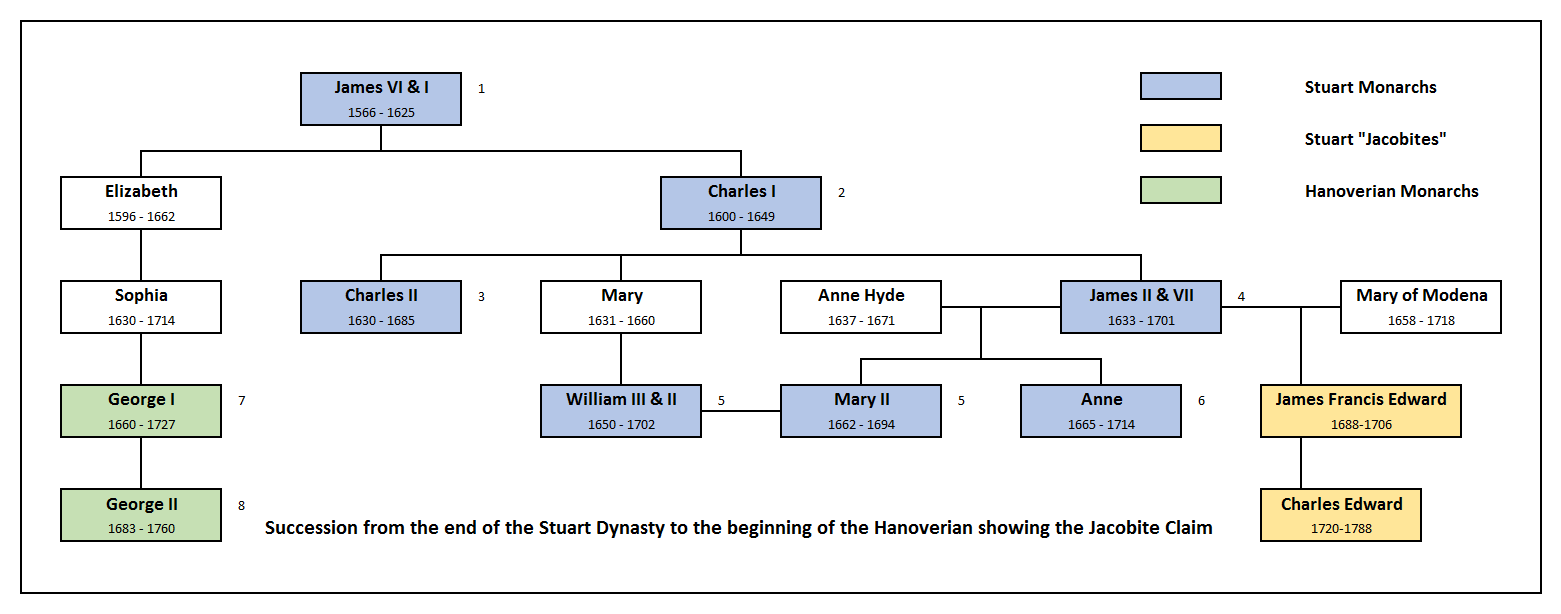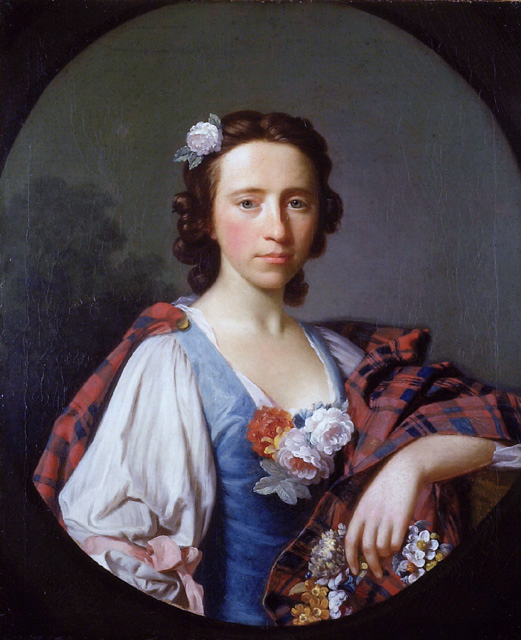In honor of International Women’s Day 2019 I thought I would repost an article about Scotland’s most famous daughter, Flora Macdonald published for the same holiday last year. Unfortunately, too many have never heard of her or the exploits which made her famous, even though the time and events she lived through have become exponentially more popular in recent years due to the success of the Outlander franchise.
So, who is Flora MacDonald, and just what did she do to become the most renowned Highland Heroine?
Jacobitism in Scotland
To understand Flora MacDonald and her deeds, you must first understand the background of Jacobitism in the history of Scotland.
The Stuart dynasty had ruled in Scotland since 1371 with the ascension of Robert II, and jointly in Scotland and England beginning in 1603. When Charles II died without a legitimate heir in 1685, he was succeeded by his brother James who reigned as James II of England and James VII of Scotland. James was unpopular with the nobles due to his Catholic faith and his efforts promoting tolerance of Catholicism. He was deposed by his Protestant daughter Mary and his son-in-law William (William and Mary) and fled to France. Parliament then passed the Bill of Rights 1689 which declared James’ retreat as abdication of the throne and legitimized succession through Mary and then her sister Anne.

William and Mary shared the crown as co-monarchs until Mary died of smallpox without producing an heir. Seeing that William would not remarry and that Anne had not yet produced an heir, Parliament passed the Act of Settlement 1701 which declared that, barring legitimate heirs of William or Anne, succession would pass to the line of Sophia, Duchess of Hanover (a granddaughter of James I and VI) and her Protestant heirs. After William’s death in 1702, Anne became queen and reigned until 1714. But she also failed to produce an heir despite 17 pregnancies which resulted in only 5 live births with none of her children surviving infancy. Sophia’s son George then became George I of Great Britain, starting the House of Hanover.
George I was initially very unpopular, due mainly to his foreign birth and lack of knowledge of English. Furthermore, there were over 50 Catholic relatives with a closer blood relationship to Queen Anne. Since James had never officially relinquished his claim to the throne, and many believed that parliamentary interference in the line of succession was illegal, a political movement to restore the heirs of James II and VII was formed. Known as Jacobites (from the Latin Jacobus for James), they openly rebelled in 1715 and in 1745. The Stuarts rallied much support from the Highland Clans during both rebellions, as many Highlanders remained Catholic.
Prince Charles Edward Stuart rallied clansmen and chiefs throughout the Western Isles with mixed success throughout July and August of 1745 but captured Edinburgh in September. Now leading 4000-5000 Highlanders, Prince Charlie marched on Prestonpans where he defeated the Hanoverian garrison. Encouraged, the army marched on London, but supply shortages, foul weather, and his generals convinced him to turn back for Scotland. Pursued by a large Hanoverian force under the Duke of Cumberland, the Jacobites made their last stand at the Battle of Culloden in April, 1746 and were soundly defeated. This effectively ended hopes of restoring a Stuart King to the throne. The story up to this point is featured in the Outlander series of books and in the second season of the Showtime series (sorry, there were no Jamie or Claire in the real story).
The Duke of Cumberland made quick work of executing the wounded and prisoners, and the monarchy would soon pass the Proscription Act (see All About Kilts for details) which disarmed Highlanders and outlawed many facets of their culture.
Prince Charles Edward Stuart was defeated, but not dead and on the run. The government had placed a bounty of £30,000 for information leading to his arrest. With the army scouring the Highlands for him, Prince Charlie crossed into the Western Isles on April 27th, hoping to find passage on the France and safety. He hid in the islands for two months, moving constantly, but by the end of June, it appeared that the army and navy were closing in on him in South Uist. A desperate plan was hatched to help his escape.
Enter Flora MacDonald
Flora MacDonald, a native of Milton on South Uist but now a resident of Armadale on Skye, was 24 years old at the time. Visiting in Milton, she was approached by representatives of Prince Charles with a plan that she escort the prince to Skye disguised as a spinning maid who was to be employed by her mother there. She agreed to help and completed all the arrangements for departure on the evening of June 28th.
After rowing out into the channel the wind turned against them and blew the boat off course overnight. They landed one Skye, but far from their intended destination. After resting, they set out again along the shoreline and were fired upon by a militia group they passed after refusing to come ashore. They landed at Kilmuir, Skye late afternoon and the prince sheltered while Flora went to contact the local Jacobite supporters who had arranged for their journey across Skye. The militia captain was unfortunately boarding with her contacts. Knowing that she had come from South Uist, he questioned her thoroughly about the potential whereabouts of the Prince, but her grace and charm (and some convincing lies) convinced him that she knew nothing of the prince. Well after dark, Flora led the prince to Uig by foot, then Kingsburg and Portree on horseback.
At Portree, Prince Charlie parted ways with Flora MacDonald and continued his escape via the nearby Island of Raasay, returning to Sky the next day and proceeding down the coast for several days on foot. He would cross back to the mainland on July 5th. He would wander the mainland until September 19th when he would secure passage on a French ship and eventually reach safety. He would spend his remaining years living in France and Italy, dying in 1788. Neither Charles, nor his brother Henry produced legitimate heirs, and the Jacobite claim to the throne died with them.
The Skye Boat Song
If any parts of this story sound familiar, it may be because it is immortalized in “The Skye Boat Song,” a popular Scottish tune. The music was first collected in the 1870’s and the lyrics were first recorded in 1888. It is thought to have originated from a rowing song and is commonly sung as a lullaby. Below are the original lyrics and an 1892 version written as a poem by Robert Louis Stevenson. Bear McCreary adapted the Stevenson version into the theme for the Outlander series (another reason this all may sound familiar).
Original Lyrics as published in 1884 Robert Louis Stevenson’s 1892 Poem
[Chorus:] [Chorus:]
Speed, bonnie boat, like a bird on the wing, Sing me a song of a lad that is gone,
Onward! the sailors cry; Say, could that lad be I?
Carry the lad that’s born to be King Merry of soul he sailed on a day
Over the sea to Skye. Over the sea to Skye.
Loud the winds howl, loud the waves roar, Mull was astern, Rum on the port,
Thunderclaps rend the air; Eigg on the starboard bow;
Baffled, our foes stand by the shore, Glory of youth glowed in his soul;
Follow they will not dare. Where is that glory now?
[Chorus] [Chorus]
Though the waves leap, soft shall ye sleep, Give me again all that was there,
Ocean’s a royal bed. Give me the sun that shone!
Rocked in the deep, Flora will keep Give me the eyes, give me the soul,
Watch by your weary head. Give me the lad that’s gone!
[Chorus] [Chorus]
Many’s the lad fought on that day, Billow and breeze, islands and seas,
Well the claymore could wield, Mountains of rain and sun,
When the night came, silently lay All that was good, all that was fair,
Dead on Culloden’s field. All that was me is gone.
[Chorus]
Burned are their homes, exile and death
Scatter the loyal men;
Yet ere the sword cool in the sheath
Charlie will come again.
Flora’s Later Life
After parting with Prince Charles on Portree, Flora continued here trip to Armadale where she lived with her mother. On July 12th, she was summoned by Captain John MacLeod who questioned her about Prince Charlie’s escape and arrested her. She initially refused to admit any involvement in the escape. During later questioning she related the full tale of her involvement. She was transported to Edinburgh and then London where she was imprisoned in the Tower of London where she would remain for eight months until she was released under the Act of Indemnity. She became quite a celebrity while in the Tower receiving regular visitors, including Frederick Prince of Wales
After returning to Skye, she met and married Allan MacDonald of Kingsburgh. They would settle near Kilmuir (near where she had landed with the Prince) and have seven children. They were visited in 1773 by Dr. Samuel Johnson and James Boswell during their travels recorded in A Journey to the Western Isles of Scotland who praised them both for his “gallantry” and her “courage and fidelity.”
In 1774, Flora and Allan sailed with their 2 oldest sons to settle in North Carolina where they developed a successful farm. But as the American Revolution flared up, Allan accepted a commission in the loyalist forces. Both of their sons joined as well, leaving Flora alone on their new farm. All three of the men were captured at the Battle of Moore’s Creek in 1776 and while they were imprisoned, their home was looted and destroyed, leaving Flora homeless. Allan was released from prison in 1777 and Flora was eventually allowed passage to join him. They relocated to Nova Scotia temporarily and returned to Scotland in 1779 where Flora would die peacefully in 1790. Her grave can be seen at Kilmuir on Skye.
Her grave reads:
Preserver of Prince Charles Edward Stuart. Her name will be mentioned in history, and if courage and fidelity be virtues, mentioned with honour.
